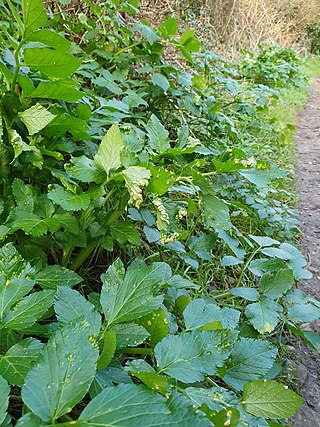
Puccinia hordei is a species of rust fungus. A plant pathogen, it can cause leaf rust of barley, also known as brown rust of barley. It was originally found on the dry leaves of Hordeum vulgare in Germany.

Puccinia coronata is a plant pathogen and causal agent of oat and barley crown rust. The pathogen occurs worldwide, infecting both wild and cultivated oats. Crown rust poses a threat to barley production, because the first infections in barley occur early in the season from local inoculum. Crown rusts have evolved many different physiological races within different species in response to host resistance. Each pathogenic race can attack a specific line of plants within the species typical host. For example, there are over 290 races of P. coronata. Crops with resistant phenotypes are often released, but within a few years virulent races have arisen and P. coronata can infect them.

Puccinia melanocephala is a fungus and plant pathogen, it is the causal agent of sugarcane rust. It was originally found on the leaves of a species of Arundinaria (cane) in Assam, India.

Puccinia menthae is a fungal plant pathogen that causes rust on mint plants. It was originally found on the leaves of Mentha aquatica.

Puccinia pelargonii-zonalis is a fungal species and plant pathogen that causes rust on Pelargonium geraniums. It was originally found on the leaves of Pelargonium zonale in KwaZulu-Natal, South Africa.

Puccinia purpurea is a fungal species and plant pathogen that causes rust on sorghum. It is found in temperate places worldwide, excluding colder parts such as Russia and Canada.
Puccinia subnitens is a fungal species and plant pathogen that causes rust on Beta vulgaris. It was originally found on Distichlis spicata in Montana, USA.

Puccinia recondita is a fungus species and plant pathogen belonging to the order of Pucciniales and family Pucciniaceae.
Puccinia bromina is a fungus species belonging to the order of Pucciniales and the family Pucciniaceae. It was originally found on Bromus arvensis in Sweden.

Uromyces is a genus of rust fungi in the family Pucciniaceae. The genus was described by Franz Unger in his 1833 work Die Exantheme der Pflanzen. They have a worldwide distribution but large occurrences happen in North America and Europe.

Puccinia malvacearum, also known as hollyhock or mallow rust, is a fungal species within the genus Puccinia known for attacking members of the family Malvaceae. An autoecious pathogen, it can complete its life cycle using a single host.

Puccinia poarum, a species of fungus, known as the coltsfoot gall rust, or meadow grass rust, is a plant pathogen. This fungal parasite forms a yellow to orange gall, 1–2 cm in diameter, on the underside of leaves of coltsfoot. It also infects but does not gall grasses of the family Poaceae. P. poarum is a genetically diverse species that has been reported on at least seventy plant hosts. It was originally found on Poa fertilis and Poa nemoralis in Denmark in 1877.

Puccinia sessilis is a fungal species and plant pathogen, which is also known as arum rust or ramsons rust. It commonly infects Arum maculatum and Allium ursinum causing yellow to orange circular patches on leaves. On the underside of the leaves, it produces raised orange aecia commonly covered in spores. It is common in Eurasia in the spring.

Puccinia oxalidis is a fungus species in the genus Puccinia. This species is a causal agent of rust on plants in the genus Oxalis, such as Oxalis articulata. The disease appears as yellow dots on the reverse of the leaves. The aecial stage can also be found on Berberis repens. It was originally found on Oxalis species in Mexico.

Hendecasis duplifascialis, the jasmine budworm, is a moth in the family Crambidae.

Puccinia umbilici is a fungal plant pathogen which causes rust on navelwort. It was originally found on the leaves of Umbilicus pendulinus in France. It is found in Europe, Japan, Russia and the United States.

Puccinia smyrnii, or alexanders rust, is a fungus species and plant pathogen which causes rust on alexanders. It was originally found in Sicily. It is found in Europe and parts of north Africa.
Myllocerus subfasciatus, is a species of weevil found in India, and Sri Lanka. The Sri Lankan population was earlier identified as a separate species, Myllocerus spurcatus.

Puccinia porri is a species of rust fungus that causes leek rust. It affects leek, garlic, onion, and chives, and usually appears as bright orange spots on infected plants.
Puccinia gansensis is a species of fungus and a plant pathogen. It was originally found on the leaves of on Achnatherum inebrians in Gansu, China.















